Taxation Law Assignment: CGT, Income, Personal Use Assets, and Income
VerifiedAdded on 2022/11/14
|11
|2832
|455
Homework Assignment
AI Summary
This assignment delves into various aspects of taxation law, analyzing capital gains tax (CGT), assessable income, and personal exertion. The first part examines CGT events, distinguishing between pre-CGT and post-CGT assets, and addressing the treatment of collectables and personal-use assets. The second part focuses on determining whether certain receipts constitute ordinary income derived from personal exertion, considering relevant case law such as Hayes v FCT and Brent v FCT. The assignment then explores the tax implications of selling copyrights and manuscripts. The final part assesses whether certain receipts are considered assessable income under ordinary concepts. The analysis includes relevant legislation and case studies to support the arguments.
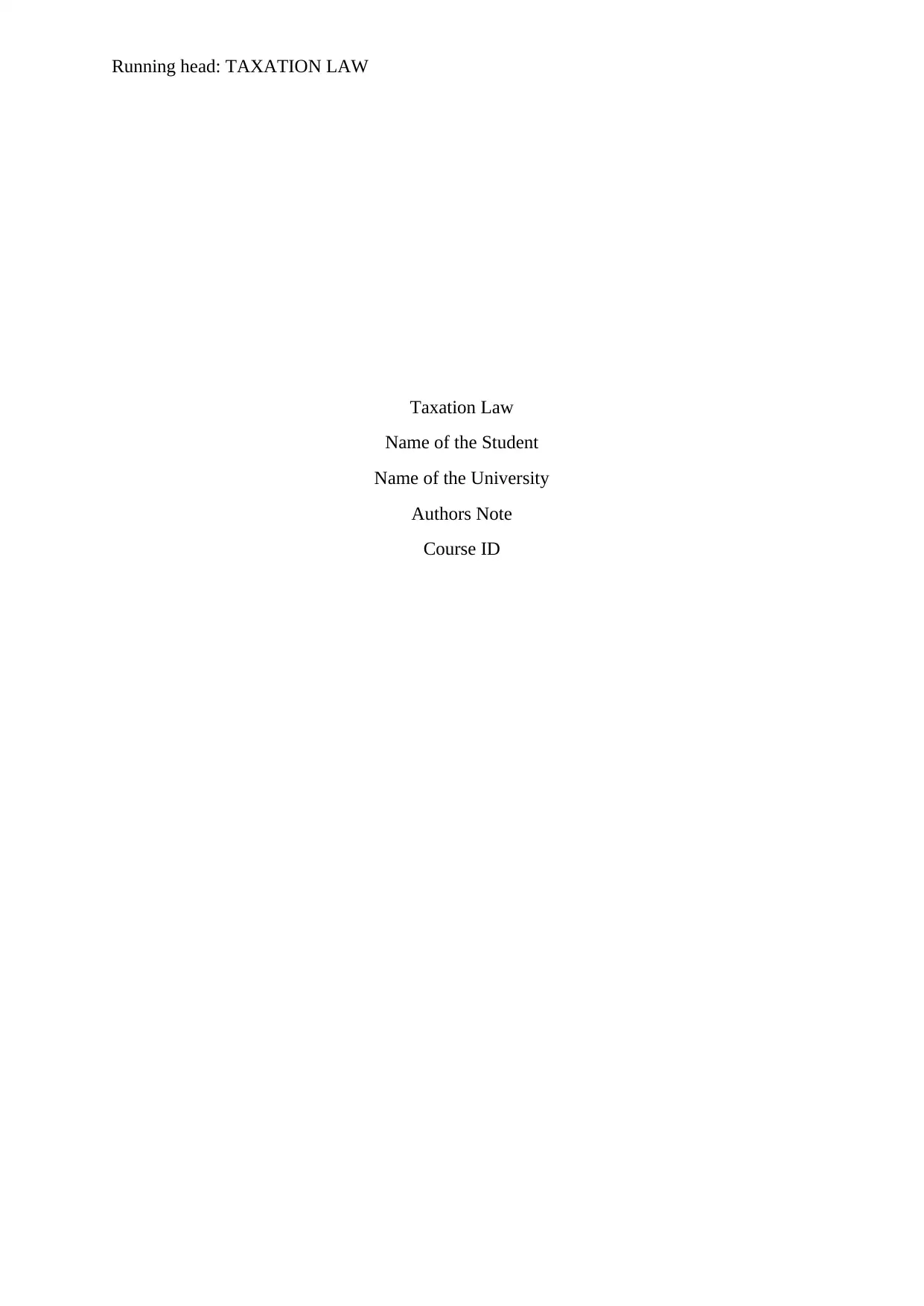
Running head: TAXATION LAW
Taxation Law
Name of the Student
Name of the University
Authors Note
Course ID
Taxation Law
Name of the Student
Name of the University
Authors Note
Course ID
Paraphrase This Document
Need a fresh take? Get an instant paraphrase of this document with our AI Paraphraser
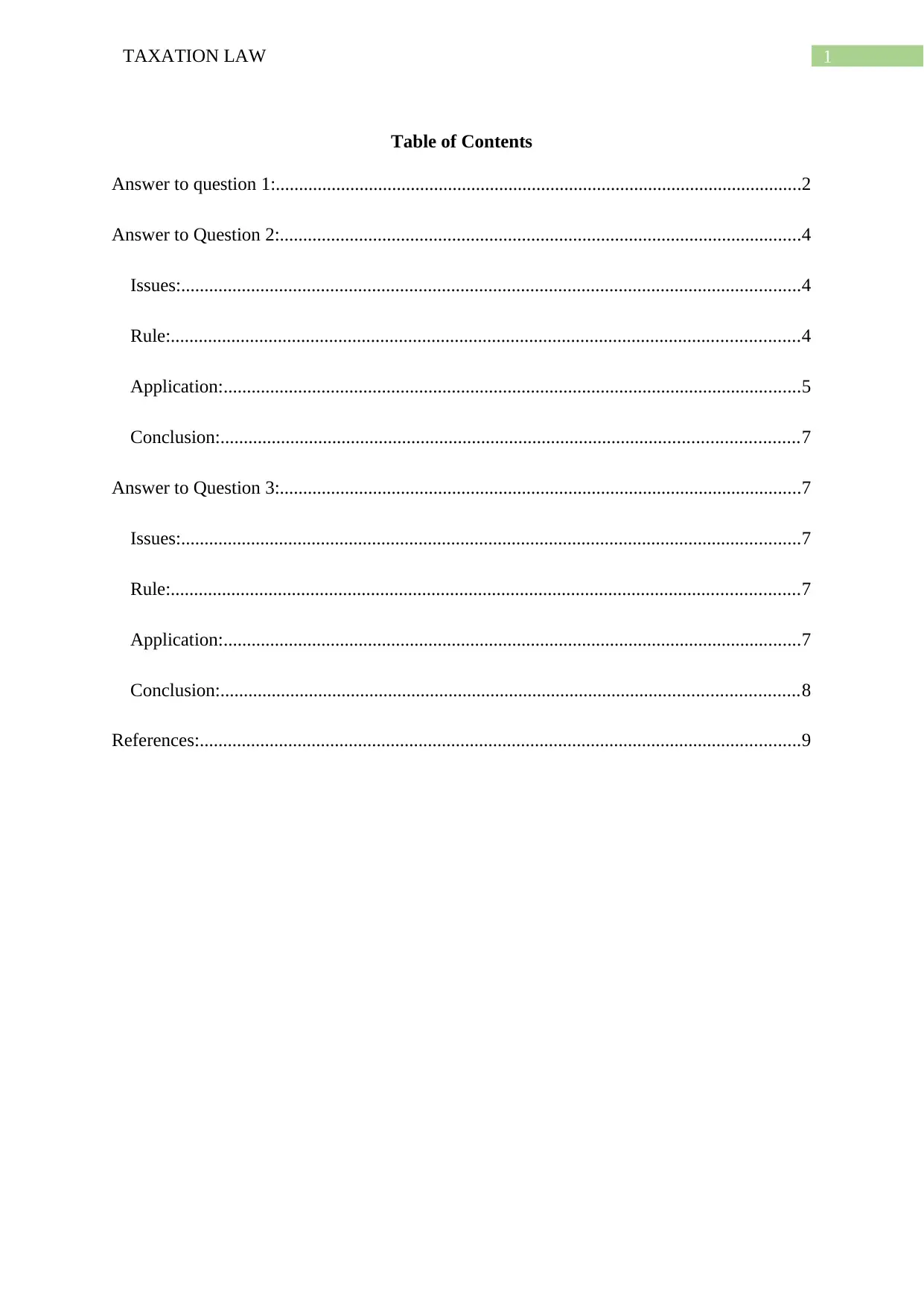
1TAXATION LAW
Table of Contents
Answer to question 1:.................................................................................................................2
Answer to Question 2:................................................................................................................4
Issues:.....................................................................................................................................4
Rule:.......................................................................................................................................4
Application:............................................................................................................................5
Conclusion:............................................................................................................................7
Answer to Question 3:................................................................................................................7
Issues:.....................................................................................................................................7
Rule:.......................................................................................................................................7
Application:............................................................................................................................7
Conclusion:............................................................................................................................8
References:.................................................................................................................................9
Table of Contents
Answer to question 1:.................................................................................................................2
Answer to Question 2:................................................................................................................4
Issues:.....................................................................................................................................4
Rule:.......................................................................................................................................4
Application:............................................................................................................................5
Conclusion:............................................................................................................................7
Answer to Question 3:................................................................................................................7
Issues:.....................................................................................................................................7
Rule:.......................................................................................................................................7
Application:............................................................................................................................7
Conclusion:............................................................................................................................8
References:.................................................................................................................................9
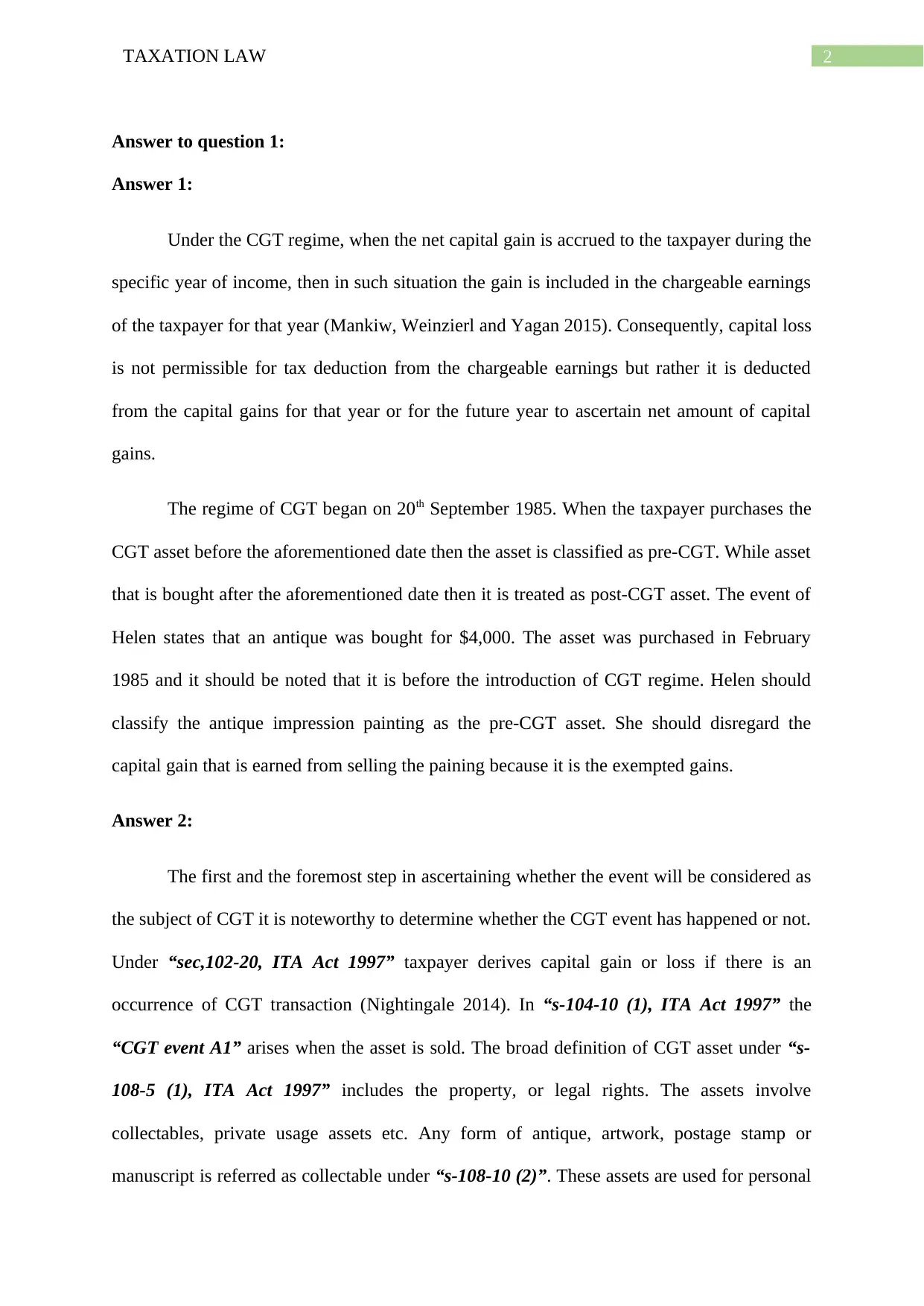
2TAXATION LAW
Answer to question 1:
Answer 1:
Under the CGT regime, when the net capital gain is accrued to the taxpayer during the
specific year of income, then in such situation the gain is included in the chargeable earnings
of the taxpayer for that year (Mankiw, Weinzierl and Yagan 2015). Consequently, capital loss
is not permissible for tax deduction from the chargeable earnings but rather it is deducted
from the capital gains for that year or for the future year to ascertain net amount of capital
gains.
The regime of CGT began on 20th September 1985. When the taxpayer purchases the
CGT asset before the aforementioned date then the asset is classified as pre-CGT. While asset
that is bought after the aforementioned date then it is treated as post-CGT asset. The event of
Helen states that an antique was bought for $4,000. The asset was purchased in February
1985 and it should be noted that it is before the introduction of CGT regime. Helen should
classify the antique impression painting as the pre-CGT asset. She should disregard the
capital gain that is earned from selling the paining because it is the exempted gains.
Answer 2:
The first and the foremost step in ascertaining whether the event will be considered as
the subject of CGT it is noteworthy to determine whether the CGT event has happened or not.
Under “sec,102-20, ITA Act 1997” taxpayer derives capital gain or loss if there is an
occurrence of CGT transaction (Nightingale 2014). In “s-104-10 (1), ITA Act 1997” the
“CGT event A1” arises when the asset is sold. The broad definition of CGT asset under “s-
108-5 (1), ITA Act 1997” includes the property, or legal rights. The assets involve
collectables, private usage assets etc. Any form of antique, artwork, postage stamp or
manuscript is referred as collectable under “s-108-10 (2)”. These assets are used for personal
Answer to question 1:
Answer 1:
Under the CGT regime, when the net capital gain is accrued to the taxpayer during the
specific year of income, then in such situation the gain is included in the chargeable earnings
of the taxpayer for that year (Mankiw, Weinzierl and Yagan 2015). Consequently, capital loss
is not permissible for tax deduction from the chargeable earnings but rather it is deducted
from the capital gains for that year or for the future year to ascertain net amount of capital
gains.
The regime of CGT began on 20th September 1985. When the taxpayer purchases the
CGT asset before the aforementioned date then the asset is classified as pre-CGT. While asset
that is bought after the aforementioned date then it is treated as post-CGT asset. The event of
Helen states that an antique was bought for $4,000. The asset was purchased in February
1985 and it should be noted that it is before the introduction of CGT regime. Helen should
classify the antique impression painting as the pre-CGT asset. She should disregard the
capital gain that is earned from selling the paining because it is the exempted gains.
Answer 2:
The first and the foremost step in ascertaining whether the event will be considered as
the subject of CGT it is noteworthy to determine whether the CGT event has happened or not.
Under “sec,102-20, ITA Act 1997” taxpayer derives capital gain or loss if there is an
occurrence of CGT transaction (Nightingale 2014). In “s-104-10 (1), ITA Act 1997” the
“CGT event A1” arises when the asset is sold. The broad definition of CGT asset under “s-
108-5 (1), ITA Act 1997” includes the property, or legal rights. The assets involve
collectables, private usage assets etc. Any form of antique, artwork, postage stamp or
manuscript is referred as collectable under “s-108-10 (2)”. These assets are used for personal
⊘ This is a preview!⊘
Do you want full access?
Subscribe today to unlock all pages.

Trusted by 1+ million students worldwide
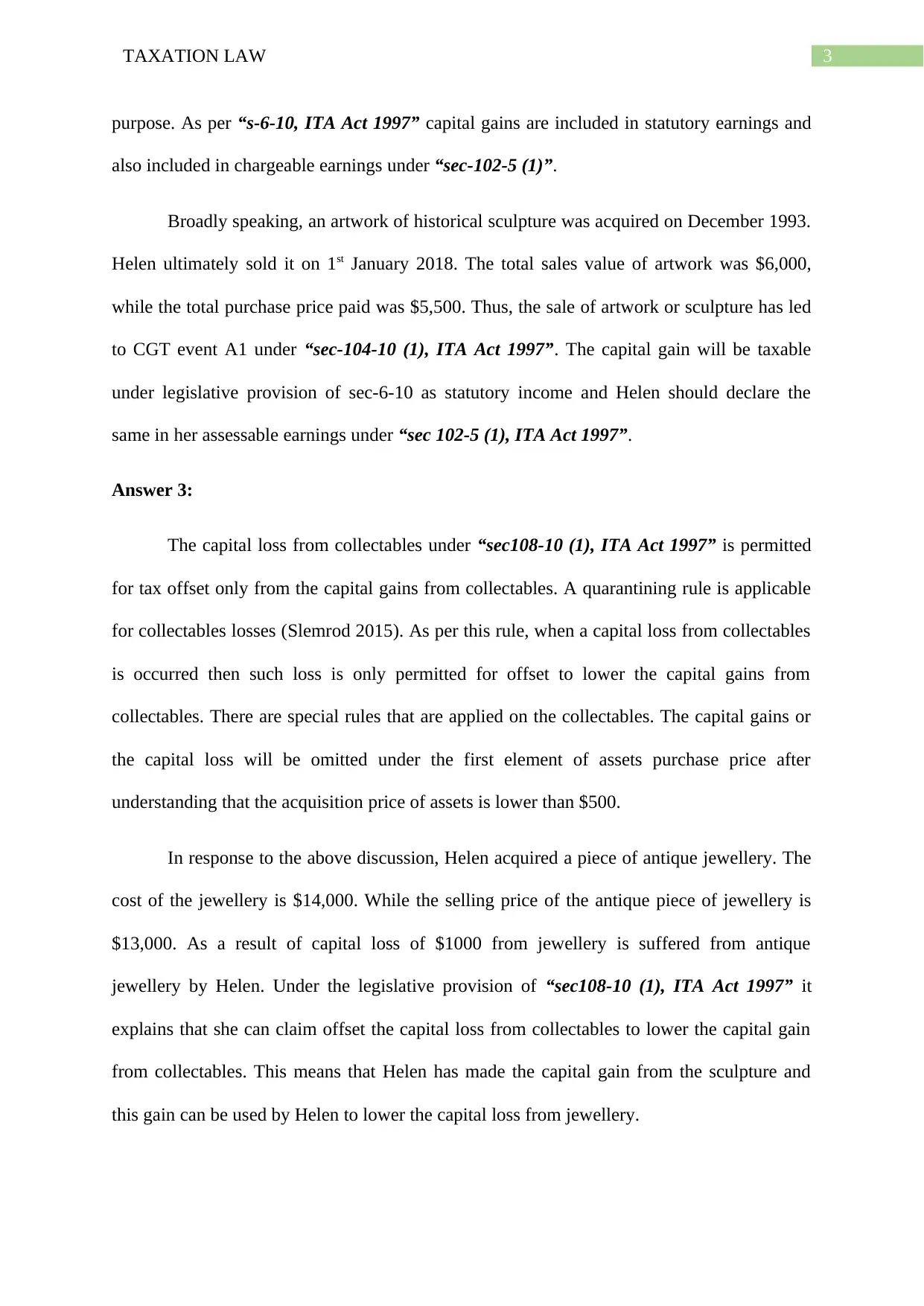
3TAXATION LAW
purpose. As per “s-6-10, ITA Act 1997” capital gains are included in statutory earnings and
also included in chargeable earnings under “sec-102-5 (1)”.
Broadly speaking, an artwork of historical sculpture was acquired on December 1993.
Helen ultimately sold it on 1st January 2018. The total sales value of artwork was $6,000,
while the total purchase price paid was $5,500. Thus, the sale of artwork or sculpture has led
to CGT event A1 under “sec-104-10 (1), ITA Act 1997”. The capital gain will be taxable
under legislative provision of sec-6-10 as statutory income and Helen should declare the
same in her assessable earnings under “sec 102-5 (1), ITA Act 1997”.
Answer 3:
The capital loss from collectables under “sec108-10 (1), ITA Act 1997” is permitted
for tax offset only from the capital gains from collectables. A quarantining rule is applicable
for collectables losses (Slemrod 2015). As per this rule, when a capital loss from collectables
is occurred then such loss is only permitted for offset to lower the capital gains from
collectables. There are special rules that are applied on the collectables. The capital gains or
the capital loss will be omitted under the first element of assets purchase price after
understanding that the acquisition price of assets is lower than $500.
In response to the above discussion, Helen acquired a piece of antique jewellery. The
cost of the jewellery is $14,000. While the selling price of the antique piece of jewellery is
$13,000. As a result of capital loss of $1000 from jewellery is suffered from antique
jewellery by Helen. Under the legislative provision of “sec108-10 (1), ITA Act 1997” it
explains that she can claim offset the capital loss from collectables to lower the capital gain
from collectables. This means that Helen has made the capital gain from the sculpture and
this gain can be used by Helen to lower the capital loss from jewellery.
purpose. As per “s-6-10, ITA Act 1997” capital gains are included in statutory earnings and
also included in chargeable earnings under “sec-102-5 (1)”.
Broadly speaking, an artwork of historical sculpture was acquired on December 1993.
Helen ultimately sold it on 1st January 2018. The total sales value of artwork was $6,000,
while the total purchase price paid was $5,500. Thus, the sale of artwork or sculpture has led
to CGT event A1 under “sec-104-10 (1), ITA Act 1997”. The capital gain will be taxable
under legislative provision of sec-6-10 as statutory income and Helen should declare the
same in her assessable earnings under “sec 102-5 (1), ITA Act 1997”.
Answer 3:
The capital loss from collectables under “sec108-10 (1), ITA Act 1997” is permitted
for tax offset only from the capital gains from collectables. A quarantining rule is applicable
for collectables losses (Slemrod 2015). As per this rule, when a capital loss from collectables
is occurred then such loss is only permitted for offset to lower the capital gains from
collectables. There are special rules that are applied on the collectables. The capital gains or
the capital loss will be omitted under the first element of assets purchase price after
understanding that the acquisition price of assets is lower than $500.
In response to the above discussion, Helen acquired a piece of antique jewellery. The
cost of the jewellery is $14,000. While the selling price of the antique piece of jewellery is
$13,000. As a result of capital loss of $1000 from jewellery is suffered from antique
jewellery by Helen. Under the legislative provision of “sec108-10 (1), ITA Act 1997” it
explains that she can claim offset the capital loss from collectables to lower the capital gain
from collectables. This means that Helen has made the capital gain from the sculpture and
this gain can be used by Helen to lower the capital loss from jewellery.
Paraphrase This Document
Need a fresh take? Get an instant paraphrase of this document with our AI Paraphraser
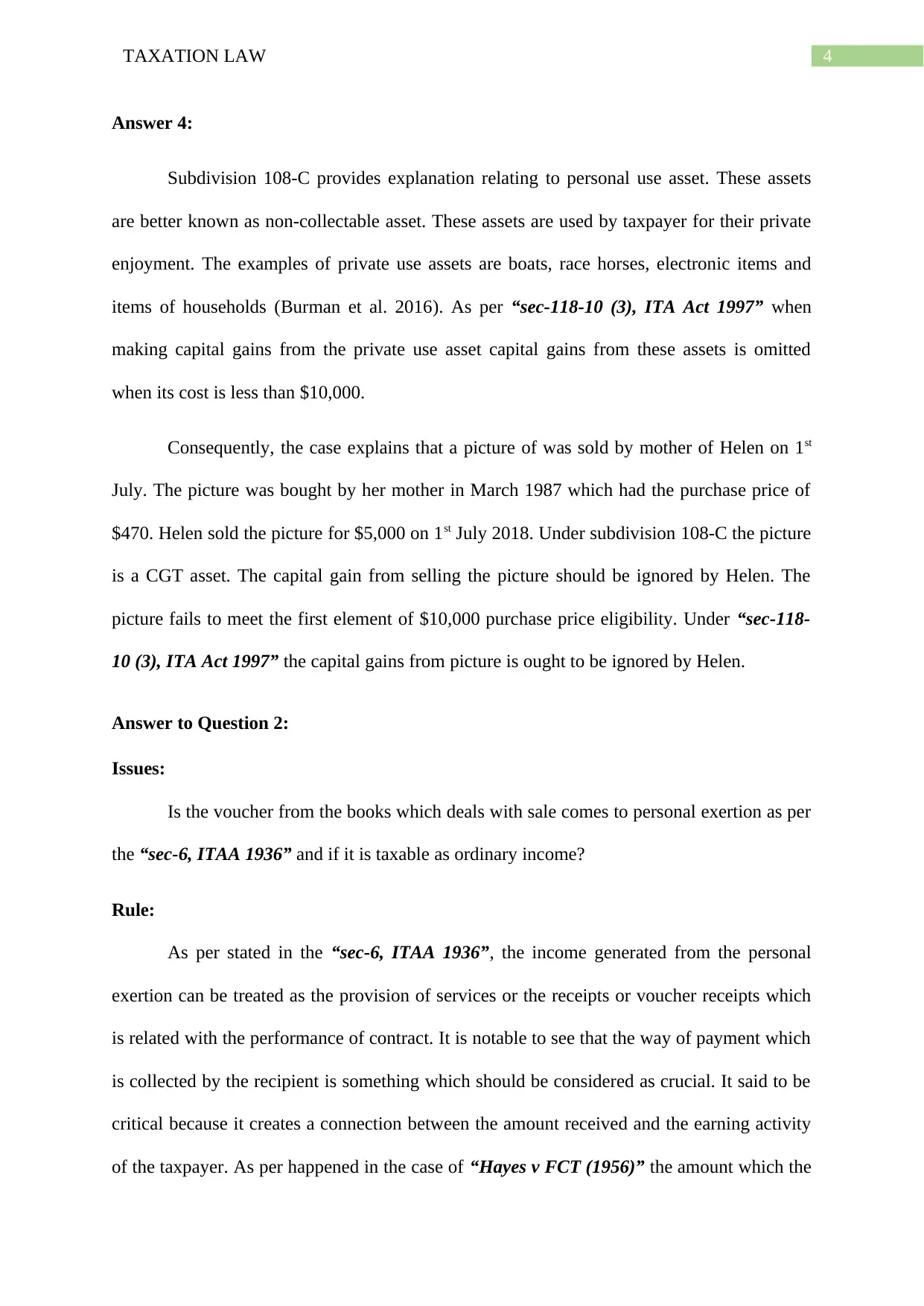
4TAXATION LAW
Answer 4:
Subdivision 108-C provides explanation relating to personal use asset. These assets
are better known as non-collectable asset. These assets are used by taxpayer for their private
enjoyment. The examples of private use assets are boats, race horses, electronic items and
items of households (Burman et al. 2016). As per “sec-118-10 (3), ITA Act 1997” when
making capital gains from the private use asset capital gains from these assets is omitted
when its cost is less than $10,000.
Consequently, the case explains that a picture of was sold by mother of Helen on 1st
July. The picture was bought by her mother in March 1987 which had the purchase price of
$470. Helen sold the picture for $5,000 on 1st July 2018. Under subdivision 108-C the picture
is a CGT asset. The capital gain from selling the picture should be ignored by Helen. The
picture fails to meet the first element of $10,000 purchase price eligibility. Under “sec-118-
10 (3), ITA Act 1997” the capital gains from picture is ought to be ignored by Helen.
Answer to Question 2:
Issues:
Is the voucher from the books which deals with sale comes to personal exertion as per
the “sec-6, ITAA 1936” and if it is taxable as ordinary income?
Rule:
As per stated in the “sec-6, ITAA 1936”, the income generated from the personal
exertion can be treated as the provision of services or the receipts or voucher receipts which
is related with the performance of contract. It is notable to see that the way of payment which
is collected by the recipient is something which should be considered as crucial. It said to be
critical because it creates a connection between the amount received and the earning activity
of the taxpayer. As per happened in the case of “Hayes v FCT (1956)” the amount which the
Answer 4:
Subdivision 108-C provides explanation relating to personal use asset. These assets
are better known as non-collectable asset. These assets are used by taxpayer for their private
enjoyment. The examples of private use assets are boats, race horses, electronic items and
items of households (Burman et al. 2016). As per “sec-118-10 (3), ITA Act 1997” when
making capital gains from the private use asset capital gains from these assets is omitted
when its cost is less than $10,000.
Consequently, the case explains that a picture of was sold by mother of Helen on 1st
July. The picture was bought by her mother in March 1987 which had the purchase price of
$470. Helen sold the picture for $5,000 on 1st July 2018. Under subdivision 108-C the picture
is a CGT asset. The capital gain from selling the picture should be ignored by Helen. The
picture fails to meet the first element of $10,000 purchase price eligibility. Under “sec-118-
10 (3), ITA Act 1997” the capital gains from picture is ought to be ignored by Helen.
Answer to Question 2:
Issues:
Is the voucher from the books which deals with sale comes to personal exertion as per
the “sec-6, ITAA 1936” and if it is taxable as ordinary income?
Rule:
As per stated in the “sec-6, ITAA 1936”, the income generated from the personal
exertion can be treated as the provision of services or the receipts or voucher receipts which
is related with the performance of contract. It is notable to see that the way of payment which
is collected by the recipient is something which should be considered as crucial. It said to be
critical because it creates a connection between the amount received and the earning activity
of the taxpayer. As per happened in the case of “Hayes v FCT (1956)” the amount which the
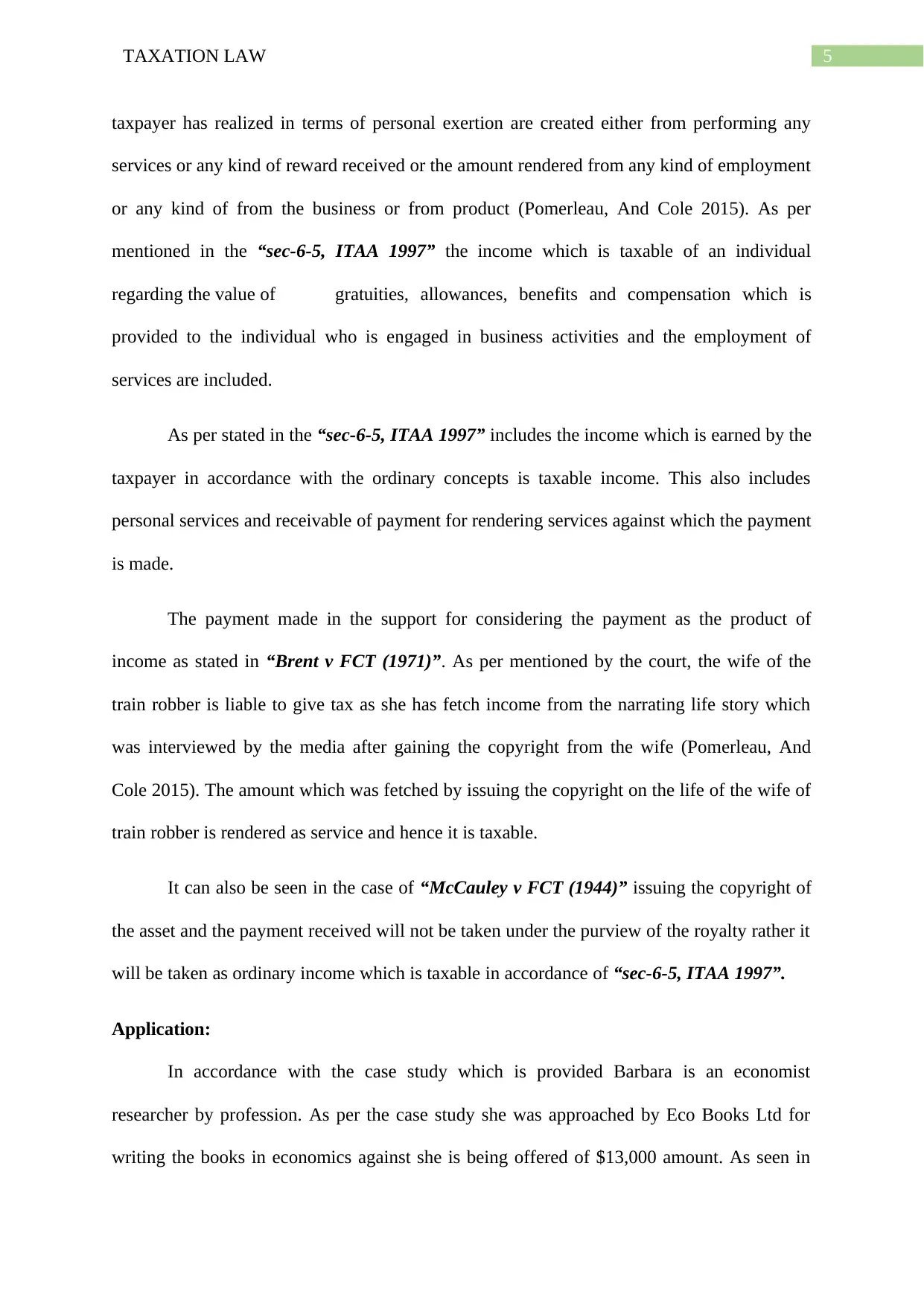
5TAXATION LAW
taxpayer has realized in terms of personal exertion are created either from performing any
services or any kind of reward received or the amount rendered from any kind of employment
or any kind of from the business or from product (Pomerleau, And Cole 2015). As per
mentioned in the “sec-6-5, ITAA 1997” the income which is taxable of an individual
regarding the value of gratuities, allowances, benefits and compensation which is
provided to the individual who is engaged in business activities and the employment of
services are included.
As per stated in the “sec-6-5, ITAA 1997” includes the income which is earned by the
taxpayer in accordance with the ordinary concepts is taxable income. This also includes
personal services and receivable of payment for rendering services against which the payment
is made.
The payment made in the support for considering the payment as the product of
income as stated in “Brent v FCT (1971)”. As per mentioned by the court, the wife of the
train robber is liable to give tax as she has fetch income from the narrating life story which
was interviewed by the media after gaining the copyright from the wife (Pomerleau, And
Cole 2015). The amount which was fetched by issuing the copyright on the life of the wife of
train robber is rendered as service and hence it is taxable.
It can also be seen in the case of “McCauley v FCT (1944)” issuing the copyright of
the asset and the payment received will not be taken under the purview of the royalty rather it
will be taken as ordinary income which is taxable in accordance of “sec-6-5, ITAA 1997”.
Application:
In accordance with the case study which is provided Barbara is an economist
researcher by profession. As per the case study she was approached by Eco Books Ltd for
writing the books in economics against she is being offered of $13,000 amount. As seen in
taxpayer has realized in terms of personal exertion are created either from performing any
services or any kind of reward received or the amount rendered from any kind of employment
or any kind of from the business or from product (Pomerleau, And Cole 2015). As per
mentioned in the “sec-6-5, ITAA 1997” the income which is taxable of an individual
regarding the value of gratuities, allowances, benefits and compensation which is
provided to the individual who is engaged in business activities and the employment of
services are included.
As per stated in the “sec-6-5, ITAA 1997” includes the income which is earned by the
taxpayer in accordance with the ordinary concepts is taxable income. This also includes
personal services and receivable of payment for rendering services against which the payment
is made.
The payment made in the support for considering the payment as the product of
income as stated in “Brent v FCT (1971)”. As per mentioned by the court, the wife of the
train robber is liable to give tax as she has fetch income from the narrating life story which
was interviewed by the media after gaining the copyright from the wife (Pomerleau, And
Cole 2015). The amount which was fetched by issuing the copyright on the life of the wife of
train robber is rendered as service and hence it is taxable.
It can also be seen in the case of “McCauley v FCT (1944)” issuing the copyright of
the asset and the payment received will not be taken under the purview of the royalty rather it
will be taken as ordinary income which is taxable in accordance of “sec-6-5, ITAA 1997”.
Application:
In accordance with the case study which is provided Barbara is an economist
researcher by profession. As per the case study she was approached by Eco Books Ltd for
writing the books in economics against she is being offered of $13,000 amount. As seen in
⊘ This is a preview!⊘
Do you want full access?
Subscribe today to unlock all pages.

Trusted by 1+ million students worldwide

6TAXATION LAW
the case study, Barbara writes the book after accepting the offer (Pomerleau, And Cole 2015).
This amount which is received by Barbara in return of the services rendered by her comes
under the purview of the taxable income as per stated in the “sec-6 ITAA 1997”. As per the
event mentioned “Hayes v FCT (1956)” this amount can be considered as the income not the
reward and hence it will be taxable. In accordance with the above mentioned case Barbara is
also liable to tax as she received the payment will be treated as the income and not the
reward.
As per the case study it is seen that the Barbara has sold her copyright to the Eco
Book Ltd for a sum of $13,400. The amount which is received by Barbara in return to the
services rendered by her for providing the copyright issue will be treated as the nominal
amount to cover the cost which is rendered from the service. As per stated in the case of
“Brent v FCT (1971)” the amount received after selling the copyright for writing the book in
economics to the Eco Book Ltd it will treated as the taxable income and not the reward which
will be taxable as per mentioned in the “sec- 6-5, ITAA 1997”.
Barbara has moved by the offer presented by the Eco Book Ltd and entered in the
contract where it states that the changing of the copyright to the company and hence the
company in return presented the amount of $13,400. The amount which was provided by the
company to Barbara will be taken as income because it is the amount which she received
against the services provided by her in writing the book (Evans, Minas and Lim 2015).
As the case study states further Barbara sold the manuscript of the book and the
interview manuscript to the library for the sum of $4,350 and $3,200. As stated in the case of
“McCauley v FCT (1944)” the amount which was collected from the selling of the items will
be treated as income which came from the personal exertion (Tran 2015). This is evident
from the concept mentioned in the “sec 6-5, ITAA 1997”.
the case study, Barbara writes the book after accepting the offer (Pomerleau, And Cole 2015).
This amount which is received by Barbara in return of the services rendered by her comes
under the purview of the taxable income as per stated in the “sec-6 ITAA 1997”. As per the
event mentioned “Hayes v FCT (1956)” this amount can be considered as the income not the
reward and hence it will be taxable. In accordance with the above mentioned case Barbara is
also liable to tax as she received the payment will be treated as the income and not the
reward.
As per the case study it is seen that the Barbara has sold her copyright to the Eco
Book Ltd for a sum of $13,400. The amount which is received by Barbara in return to the
services rendered by her for providing the copyright issue will be treated as the nominal
amount to cover the cost which is rendered from the service. As per stated in the case of
“Brent v FCT (1971)” the amount received after selling the copyright for writing the book in
economics to the Eco Book Ltd it will treated as the taxable income and not the reward which
will be taxable as per mentioned in the “sec- 6-5, ITAA 1997”.
Barbara has moved by the offer presented by the Eco Book Ltd and entered in the
contract where it states that the changing of the copyright to the company and hence the
company in return presented the amount of $13,400. The amount which was provided by the
company to Barbara will be taken as income because it is the amount which she received
against the services provided by her in writing the book (Evans, Minas and Lim 2015).
As the case study states further Barbara sold the manuscript of the book and the
interview manuscript to the library for the sum of $4,350 and $3,200. As stated in the case of
“McCauley v FCT (1944)” the amount which was collected from the selling of the items will
be treated as income which came from the personal exertion (Tran 2015). This is evident
from the concept mentioned in the “sec 6-5, ITAA 1997”.
Paraphrase This Document
Need a fresh take? Get an instant paraphrase of this document with our AI Paraphraser
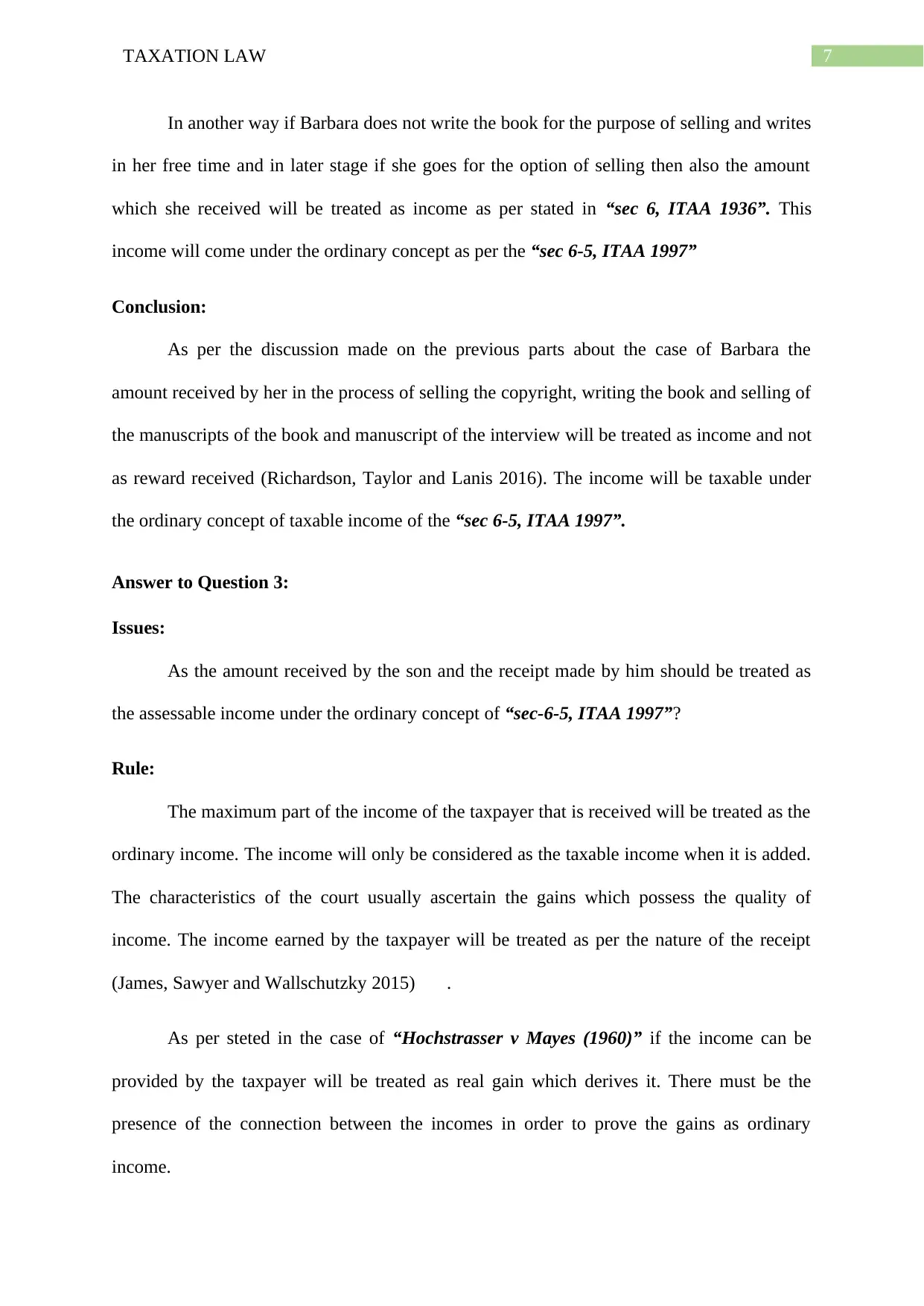
7TAXATION LAW
In another way if Barbara does not write the book for the purpose of selling and writes
in her free time and in later stage if she goes for the option of selling then also the amount
which she received will be treated as income as per stated in “sec 6, ITAA 1936”. This
income will come under the ordinary concept as per the “sec 6-5, ITAA 1997”
Conclusion:
As per the discussion made on the previous parts about the case of Barbara the
amount received by her in the process of selling the copyright, writing the book and selling of
the manuscripts of the book and manuscript of the interview will be treated as income and not
as reward received (Richardson, Taylor and Lanis 2016). The income will be taxable under
the ordinary concept of taxable income of the “sec 6-5, ITAA 1997”.
Answer to Question 3:
Issues:
As the amount received by the son and the receipt made by him should be treated as
the assessable income under the ordinary concept of “sec-6-5, ITAA 1997”?
Rule:
The maximum part of the income of the taxpayer that is received will be treated as the
ordinary income. The income will only be considered as the taxable income when it is added.
The characteristics of the court usually ascertain the gains which possess the quality of
income. The income earned by the taxpayer will be treated as per the nature of the receipt
(James, Sawyer and Wallschutzky 2015) .
As per steted in the case of “Hochstrasser v Mayes (1960)” if the income can be
provided by the taxpayer will be treated as real gain which derives it. There must be the
presence of the connection between the incomes in order to prove the gains as ordinary
income.
In another way if Barbara does not write the book for the purpose of selling and writes
in her free time and in later stage if she goes for the option of selling then also the amount
which she received will be treated as income as per stated in “sec 6, ITAA 1936”. This
income will come under the ordinary concept as per the “sec 6-5, ITAA 1997”
Conclusion:
As per the discussion made on the previous parts about the case of Barbara the
amount received by her in the process of selling the copyright, writing the book and selling of
the manuscripts of the book and manuscript of the interview will be treated as income and not
as reward received (Richardson, Taylor and Lanis 2016). The income will be taxable under
the ordinary concept of taxable income of the “sec 6-5, ITAA 1997”.
Answer to Question 3:
Issues:
As the amount received by the son and the receipt made by him should be treated as
the assessable income under the ordinary concept of “sec-6-5, ITAA 1997”?
Rule:
The maximum part of the income of the taxpayer that is received will be treated as the
ordinary income. The income will only be considered as the taxable income when it is added.
The characteristics of the court usually ascertain the gains which possess the quality of
income. The income earned by the taxpayer will be treated as per the nature of the receipt
(James, Sawyer and Wallschutzky 2015) .
As per steted in the case of “Hochstrasser v Mayes (1960)” if the income can be
provided by the taxpayer will be treated as real gain which derives it. There must be the
presence of the connection between the incomes in order to prove the gains as ordinary
income.
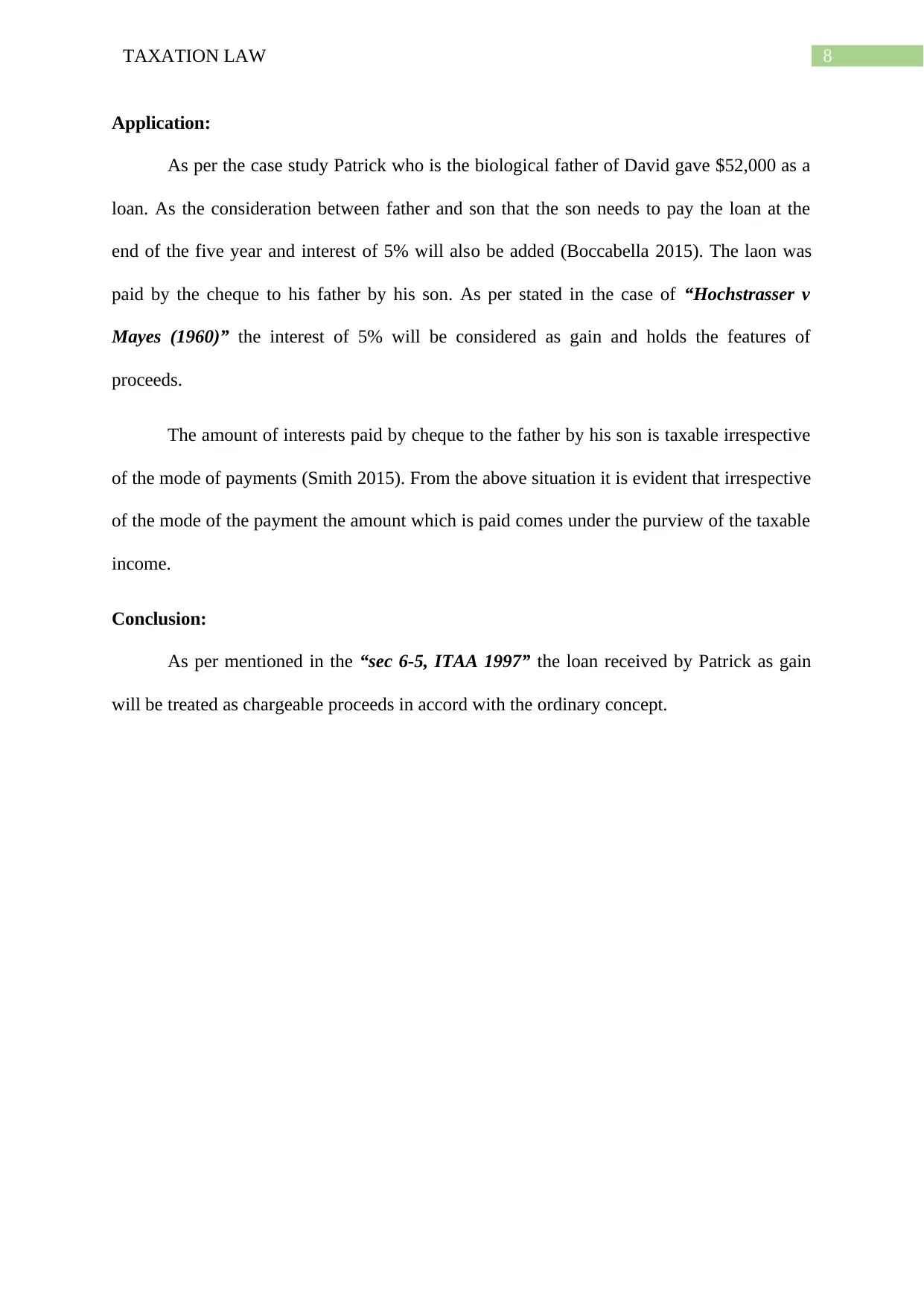
8TAXATION LAW
Application:
As per the case study Patrick who is the biological father of David gave $52,000 as a
loan. As the consideration between father and son that the son needs to pay the loan at the
end of the five year and interest of 5% will also be added (Boccabella 2015). The laon was
paid by the cheque to his father by his son. As per stated in the case of “Hochstrasser v
Mayes (1960)” the interest of 5% will be considered as gain and holds the features of
proceeds.
The amount of interests paid by cheque to the father by his son is taxable irrespective
of the mode of payments (Smith 2015). From the above situation it is evident that irrespective
of the mode of the payment the amount which is paid comes under the purview of the taxable
income.
Conclusion:
As per mentioned in the “sec 6-5, ITAA 1997” the loan received by Patrick as gain
will be treated as chargeable proceeds in accord with the ordinary concept.
Application:
As per the case study Patrick who is the biological father of David gave $52,000 as a
loan. As the consideration between father and son that the son needs to pay the loan at the
end of the five year and interest of 5% will also be added (Boccabella 2015). The laon was
paid by the cheque to his father by his son. As per stated in the case of “Hochstrasser v
Mayes (1960)” the interest of 5% will be considered as gain and holds the features of
proceeds.
The amount of interests paid by cheque to the father by his son is taxable irrespective
of the mode of payments (Smith 2015). From the above situation it is evident that irrespective
of the mode of the payment the amount which is paid comes under the purview of the taxable
income.
Conclusion:
As per mentioned in the “sec 6-5, ITAA 1997” the loan received by Patrick as gain
will be treated as chargeable proceeds in accord with the ordinary concept.
⊘ This is a preview!⊘
Do you want full access?
Subscribe today to unlock all pages.

Trusted by 1+ million students worldwide
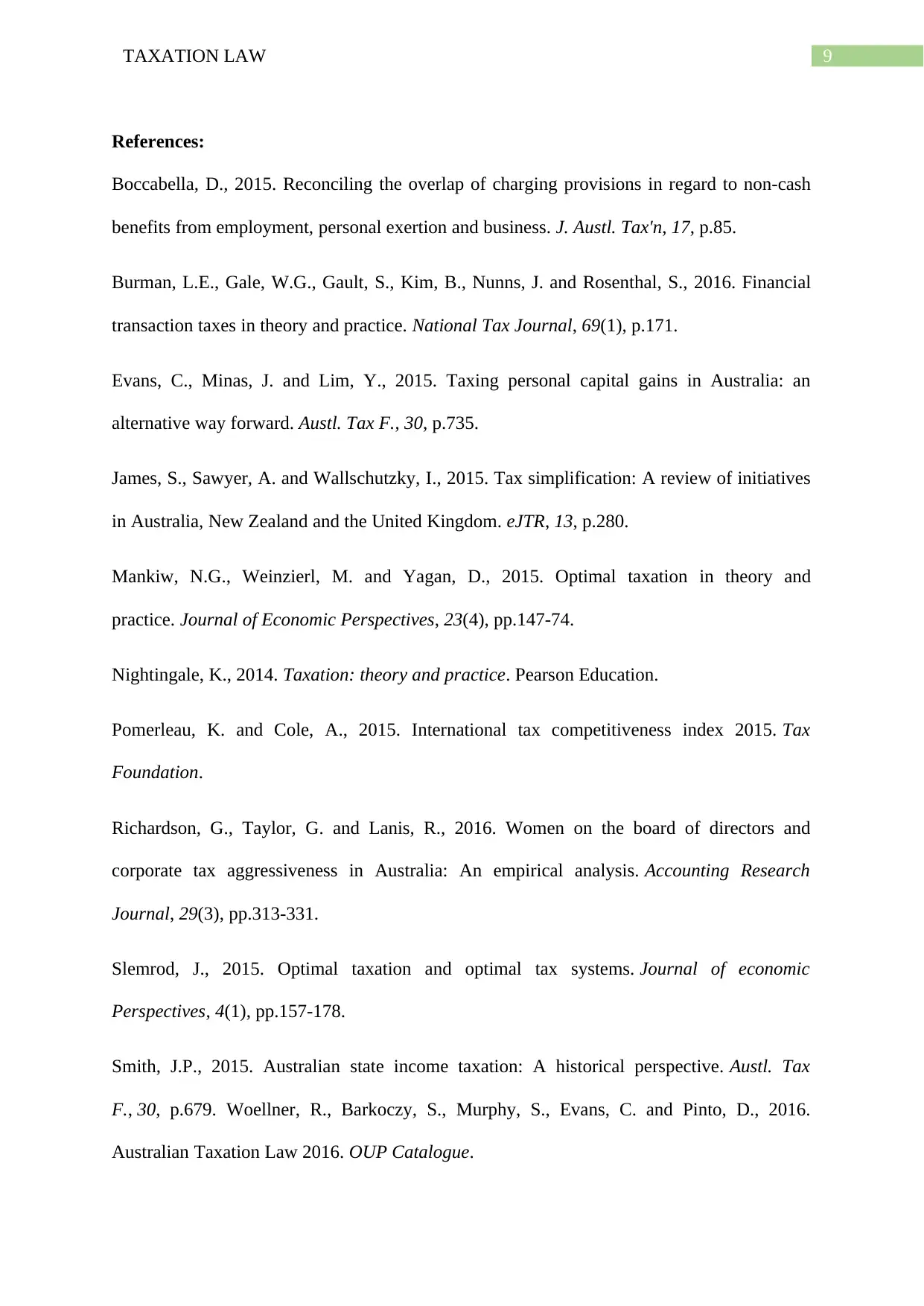
9TAXATION LAW
References:
Boccabella, D., 2015. Reconciling the overlap of charging provisions in regard to non-cash
benefits from employment, personal exertion and business. J. Austl. Tax'n, 17, p.85.
Burman, L.E., Gale, W.G., Gault, S., Kim, B., Nunns, J. and Rosenthal, S., 2016. Financial
transaction taxes in theory and practice. National Tax Journal, 69(1), p.171.
Evans, C., Minas, J. and Lim, Y., 2015. Taxing personal capital gains in Australia: an
alternative way forward. Austl. Tax F., 30, p.735.
James, S., Sawyer, A. and Wallschutzky, I., 2015. Tax simplification: A review of initiatives
in Australia, New Zealand and the United Kingdom. eJTR, 13, p.280.
Mankiw, N.G., Weinzierl, M. and Yagan, D., 2015. Optimal taxation in theory and
practice. Journal of Economic Perspectives, 23(4), pp.147-74.
Nightingale, K., 2014. Taxation: theory and practice. Pearson Education.
Pomerleau, K. and Cole, A., 2015. International tax competitiveness index 2015. Tax
Foundation.
Richardson, G., Taylor, G. and Lanis, R., 2016. Women on the board of directors and
corporate tax aggressiveness in Australia: An empirical analysis. Accounting Research
Journal, 29(3), pp.313-331.
Slemrod, J., 2015. Optimal taxation and optimal tax systems. Journal of economic
Perspectives, 4(1), pp.157-178.
Smith, J.P., 2015. Australian state income taxation: A historical perspective. Austl. Tax
F., 30, p.679. Woellner, R., Barkoczy, S., Murphy, S., Evans, C. and Pinto, D., 2016.
Australian Taxation Law 2016. OUP Catalogue.
References:
Boccabella, D., 2015. Reconciling the overlap of charging provisions in regard to non-cash
benefits from employment, personal exertion and business. J. Austl. Tax'n, 17, p.85.
Burman, L.E., Gale, W.G., Gault, S., Kim, B., Nunns, J. and Rosenthal, S., 2016. Financial
transaction taxes in theory and practice. National Tax Journal, 69(1), p.171.
Evans, C., Minas, J. and Lim, Y., 2015. Taxing personal capital gains in Australia: an
alternative way forward. Austl. Tax F., 30, p.735.
James, S., Sawyer, A. and Wallschutzky, I., 2015. Tax simplification: A review of initiatives
in Australia, New Zealand and the United Kingdom. eJTR, 13, p.280.
Mankiw, N.G., Weinzierl, M. and Yagan, D., 2015. Optimal taxation in theory and
practice. Journal of Economic Perspectives, 23(4), pp.147-74.
Nightingale, K., 2014. Taxation: theory and practice. Pearson Education.
Pomerleau, K. and Cole, A., 2015. International tax competitiveness index 2015. Tax
Foundation.
Richardson, G., Taylor, G. and Lanis, R., 2016. Women on the board of directors and
corporate tax aggressiveness in Australia: An empirical analysis. Accounting Research
Journal, 29(3), pp.313-331.
Slemrod, J., 2015. Optimal taxation and optimal tax systems. Journal of economic
Perspectives, 4(1), pp.157-178.
Smith, J.P., 2015. Australian state income taxation: A historical perspective. Austl. Tax
F., 30, p.679. Woellner, R., Barkoczy, S., Murphy, S., Evans, C. and Pinto, D., 2016.
Australian Taxation Law 2016. OUP Catalogue.
Paraphrase This Document
Need a fresh take? Get an instant paraphrase of this document with our AI Paraphraser
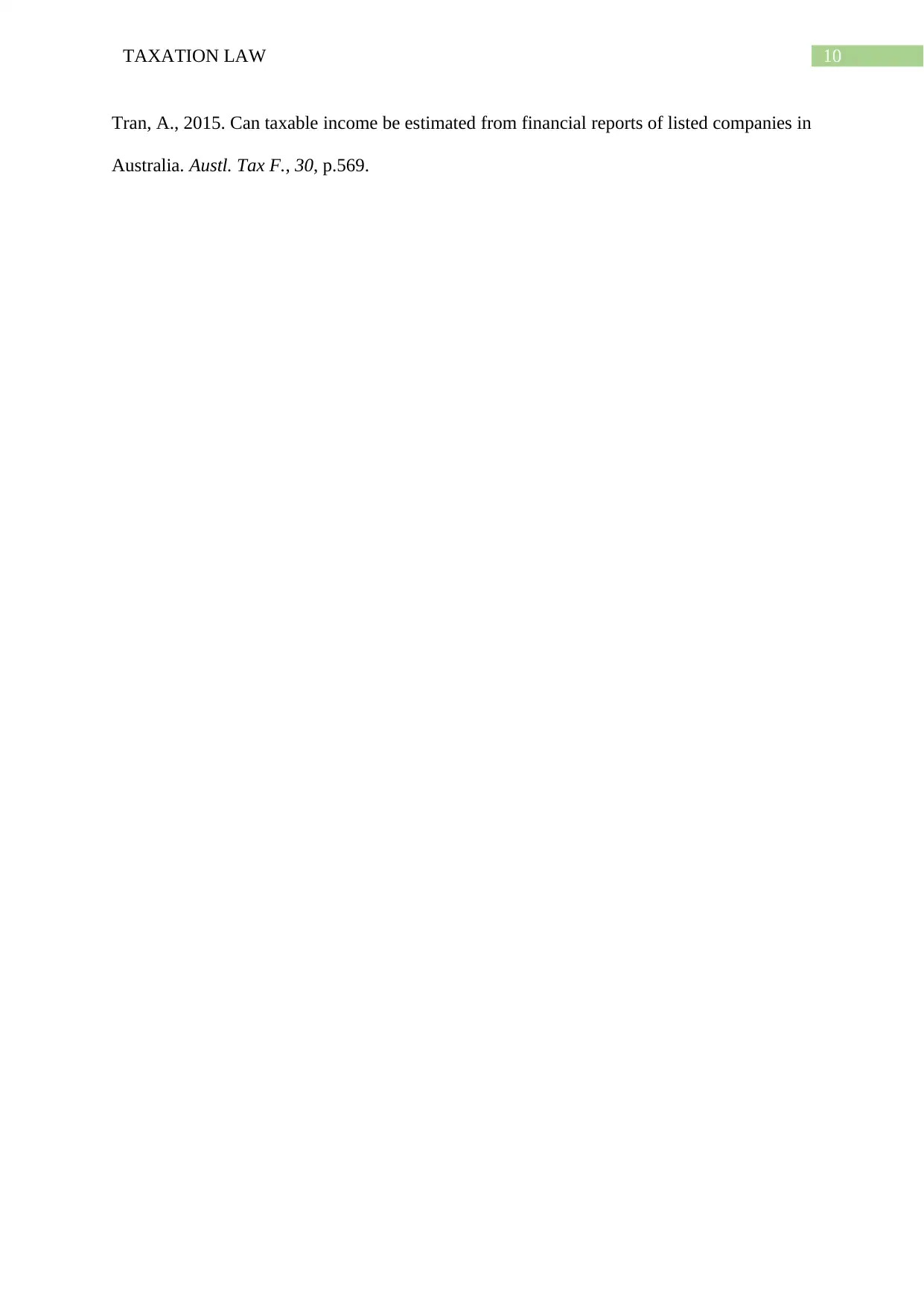
10TAXATION LAW
Tran, A., 2015. Can taxable income be estimated from financial reports of listed companies in
Australia. Austl. Tax F., 30, p.569.
Tran, A., 2015. Can taxable income be estimated from financial reports of listed companies in
Australia. Austl. Tax F., 30, p.569.
1 out of 11
Related Documents
Your All-in-One AI-Powered Toolkit for Academic Success.
+13062052269
info@desklib.com
Available 24*7 on WhatsApp / Email
![[object Object]](/_next/static/media/star-bottom.7253800d.svg)
Unlock your academic potential
Copyright © 2020–2025 A2Z Services. All Rights Reserved. Developed and managed by ZUCOL.




